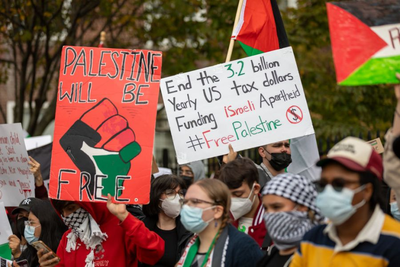
(NewsNation) — Pro-Palestinian demonstrators carried out a coordinated, coast-to-coast protest Monday, temporarily shutting down travel into some of the nation's busiest airports and bridges as protesters called for a permanent cease-fire in Gaza.
The group behind the large-scale protests is called A15, a movement that called for a coordinated economic blockade on April 15 in an effort to free Palestine.
"There is a need to shift from symbolic actions to those that cause pain to the economy," the group wrote online.
Where were pro-Palestinian protests held?
On the Monday in question, traffic in the San Francisco Bay Area was snarled for hours as demonstrators shut down all vehicle, pedestrian and bike traffic on the Golden Gate Bridge and chained themselves to 55-gallon drums filled with cement across Interstate 880 in Oakland.
Protesters marching into Brooklyn blocked Manhattan-bound traffic on the Brooklyn Bridge. In Eugene, Oregon, protesters blocked Interstate 5, shutting down traffic on the major highway for about 45 minutes.
New York Police made several arrests, saying 150 individuals were initially involved in the march around 3:15 p.m. The number of demonstrators quickly grew, but the bridge was fully reopened by 5 p.m.
Oregon State Police said 52 protesters were arrested for disorderly conduct, and six vehicles were towed from the scene, according to the Associated Press.
In Chicago, protesters linked arms and blocked lanes of Interstate 190 leading into O’Hare International Airport in a demonstration they said was part of a global “economic blockade to free Palestine,” according to Rifqa Falaneh, one of the organizers. Protesters say they chose O’Hare in part because it is one of the largest airports.
Chicago police said “multiple people” were taken into custody, but they did not have a detailed count.
Monday's demonstrations weren't just meant to block the economy in the U.S., as the group A15 announced demonstrations from Mexico City to Seoul, South Korea.
What is A15?
The group behind the global protests on Monday calls itself A15 for April 15.
"The proposal states that in each city, we will identify and blockade major choke points in the economy, focusing on points of production and circulation with the aim of causing the most economic impact," the group wrote online.
The agreement included a promise for the cities to act in solidarity, with each city taking responsibility for planning and carrying out its own actions.
According to its website, participating cities included Ho Chi Min, Vietnam; Melbourne, Australia; Brussels, Belgium; London; Athens; Dublin and more.
NewsNation reached out to A15 for comment but has not heard back.
What are people saying?
Some are now calling on the federal government to pay attention to these kinds of demonstrations.
"Unfortunately, they feel and are being allowed access to creating these types of disturbances. And there is, again, an absence of law enforcement. It's mind-boggling to me that this doesn't attract the sort of federal attention that it should, and perhaps their attention is diverted elsewhere, but this is exactly the type of threat that needs to be enforced," said Robert Greenway, former senior director of the National Security Council.
Madeline Hannan was headed to Chicago's O'Hare Airport when the demonstration broke out. She said her car was stalled on the highway for over 20 minutes and ultimately had to walk more than a mile to barely reach her gate in time.
“This was an inconvenience,” she told the Associated Press. “But in the grand scheme of things going on overseas, it’s a minor inconvenience.”
While individual travelers may have been affected, operations at the airport appeared near normal, with delays of under 15 minutes, according to the Chicago Department of Aviation.